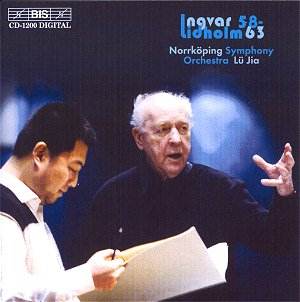This typically enterprising BIS disc could carry
the subtitle ‘The approachable face of post-war modernism’. As
a member of Karl-Birger Blomdahl’s influential ‘Monday Group’,
Lidholm, like his teacher Hilding Rosenberg, absorbed many of
the musical ideas seeping through from the central European avant-garde
of the 1920s onwards. It is possible to hear traces of Stravinsky,
Bartók and Hindemith, as well as the emerging voices of
Ligeti, Nono and Messiaen, while constantly being aware of a distinctly
fresh musical voice.
All the works here are for conventional orchestra
(large and small) with occasional forays into electronics, and
all are accessible and rewarding. Mutanza was written
for the 50th anniversary of the Orebro Orchestral Society
in 1959. Lidholm knew the city well, having held the post of music
director there from 1947 to 1956. The piece is certainly no festive
fanfare. The title mutanza comes from a little known 16th
century term meaning ‘variation’, though the composer tells us
not to read too much into that, and there is no real feeling of
variation form in its strictest sense. Rather, the composer plays
with orchestral sonorities and richly varying dynamic shifts,
alternating density of texture with emotional intensity. This
is apparent from the start, where the music grows out of the faint
sighs of a cymbal, building and subsiding in waves of diffuse
instrumental colour.
Notturno-Canto started life as
a cantata, reaching this modified two-movement form as recently
as 2000. It is based on the final lines of a confessional poem
by Carl Jonas Almqvist entitled ‘Night of the Poet’, a sort of
dream fantasy on big issues (life, divinity, eternity etc.). As
the title suggests, we are drawn into a nocturnal world of mystery
and meditation, where delicate woodwind arabesques alternate with
dramatic percussion outbursts to produce tension and drama. It
is highly effective scoring, and the rather naïve poetry
takes on a more nightmarish, almost expressionistic quality when
the solo soprano is heard against this orchestral background.
Motus-colores was written to a
commission by Germany’s Südwestrundfunk, who asked for ‘a
work for large chamber orchestra with dominant percussion’. It
is to Lidholm’s credit that he uses his extensive orchestral apparatus
with real refinement and no hint of cheap sensationalism. His
title literally means ‘movement-colours’, and the composer tells
us he felt the need to use every instrument ‘with the greatest
possible differentiation. The colouristic aspect thereby becomes
central with movement becoming the natural complement; the synthesis
then gains its character’. The melodic language is basically serial,
but once again the woodwind cadenzas and flourishes give it an
almost impressionistic character.
The longest piece on the disc is Riter,
meaning ‘Rites’, and here we do get strong hints of the most famous
orchestral ritual of all, The Rite of Spring. This is partly
because Lidholm’s work is also a ballet and relies heavily on
accented rhythms and driving, barbaric textures. It has a similar
scenario (with hints of Miraculous Mandarin) which talks
of magic circles, a youth and a maiden in a passionate, frenzied
dance, a procession which includes a sacrifice etc. Even the composer’s
words regarding its conception remind one of Stravinsky, who famously
said "I heard, and I wrote what I heard". Lidholm tells
us that he "… saw it just like that … scene by scene it took
form, and I merely had to follow it and write it down". It
is greatly to his credit that the aural allusions to The Rite
are only fleeting. Again we have a score where the rhythmically
forceful sections (such as the opening Rituella danser)
are contrasted by sections of shimmering beauty and lyricism.
He even manages a nod to the modernist trend of electro-acoustic
‘concrete music’, the application of taped everyday sounds, in
this case distorted recordings of goats and sheep (track 6). It’s
less effective than the ‘real’ music, and one feels that Lidholm
is more at home writing for proper instruments. It’s a pity that
this effective score is not more widely heard.
All in all, BIS have done Sweden’s foremost living
composer a great service with this release. He is not exactly
over-represented on record, and one can only hope for more from
this source. All the performances are enthusiastic and committed,
and the sound quality is well up to house standards. Excellent
notes by Stig Jacobsson, who also quotes at length from the composer
himself. Highly recommended.
Tony Haywood
